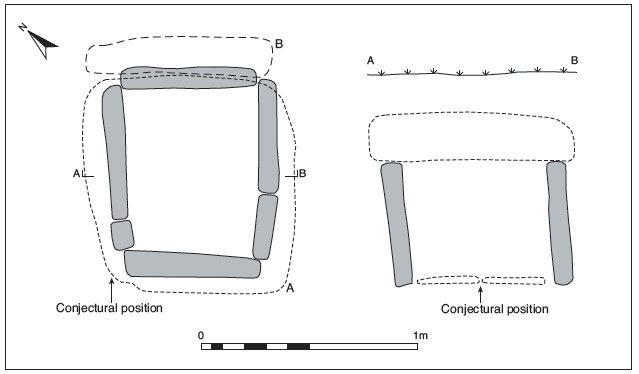1961:014 - EARDOWNES GREAT, CO. WEXFORD, Wexford
County: Wexford
Site name: EARDOWNES GREAT, CO. WEXFORD
Sites and Monuments Record No.: SMR WX053-017
Licence number: E1182
Author: BREANDÁN Ó RÍORDÁIN
Author/Organisation Address: —
Site type: Early Bronze Age graves
Period/Dating: —
ITM: E 711074m, N 607630m
Latitude, Longitude (decimal degrees): 52.209235, -6.374749
Introduction
In February 1961 a short cist was discovered during ploughing operations on a farm near Broadway, Co. Wexford. The cist was discovered 0.23m below ground level and was reported to Dr G.W. Hadden and other members of the Old Wexford Society. The site was excavated under the supervision of Messrs P. Doran, J. Jeffrey and P. Foley, members of the Old Wexford Society. The site was then visited by Mr Breandán Ó Ríordáin. This report is based on Ó Ríordáin’s account of the site.
Location (Fig. 3.216)
The site was in the townland of Eardownes Great, south-east Co. Wexford.356 It lay just a few metres from the coast, at the south-eastern tip of County Wexford, at an altitude of 15–30m above sea level. No sites of similar date are known from the townland.
Description of site
The cist was rectangular in plan, with its long axis aligned north-east/south-west. It measured 0.73m long by 0.61m wide by 0.4m deep internally (Fig. 3.217). The chamber was constructed of six edge-set slabs, varying in thickness from 0.12m to 0.28m. The cist ends were formed of one slab each, while the sides were each constructed of one main slab with a

Fig. 3.216—Location map, Eardownes Great, Co. Wexford.

Fig. 3.217—Plan and section of cist, Eardownes Great, Co. Wexford.
short slab added to lengthen the cist area. There was no evidence for packing stones around the outside of the cist. The cist was sealed by two capstones, one of which (capstone A on plan) was broken up before the site was inspected. This had covered the cist almost completely, but a second, narrower slab (capstone B on plan) supplemented it at the north- eastern end. According to the excavators, the floor of the cist had been paved with three light, narrow slabs, but these had been taken up before Ó Ríordáin’s investigation.
The cist contained a small quantity of soil, which had apparently percolated in through the interstices, but no human remains or artefacts were found. The fill material was carefully preserved in a barrel and was examined by Ó Ríordáin, but no finds were present.
Comment
This site is assumed to be early Bronze Age in date on the basis of its form. There is no evidence to suggest any previous disturbance that might explain the lack of both human remains and any other objects. It may be that soil conditions resulted in the complete decay of any human remains, but this would be very unusual. Is there a possibility that sites were constructed in advance with the intention of using them at the appropriate time but that, for whatever reason, the prepared cist was never used? This might explain the empty cists recorded at sites such as Ballyoskill, Co. Kilkenny (this volume, pp 235–43).
356. Parish of Ladysisland, barony of Forth. SMR WX053-017——. IGR 311148 107576.
